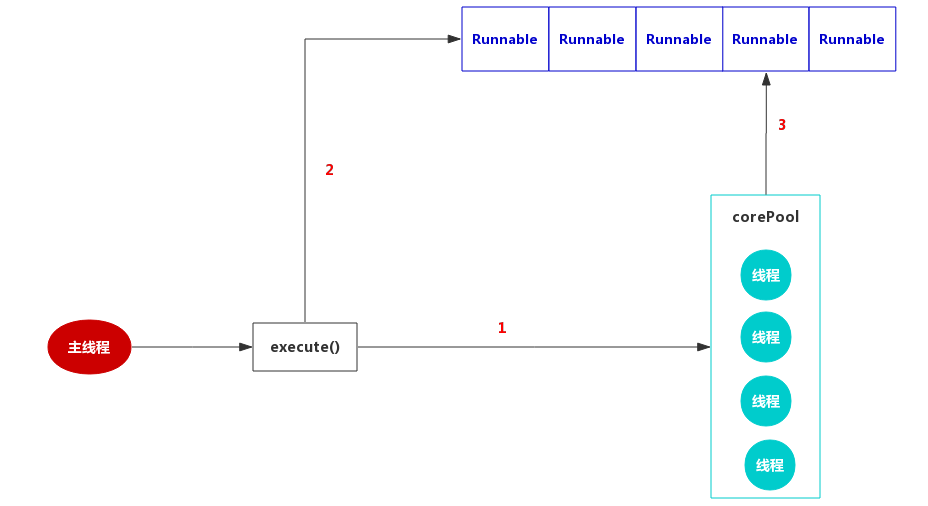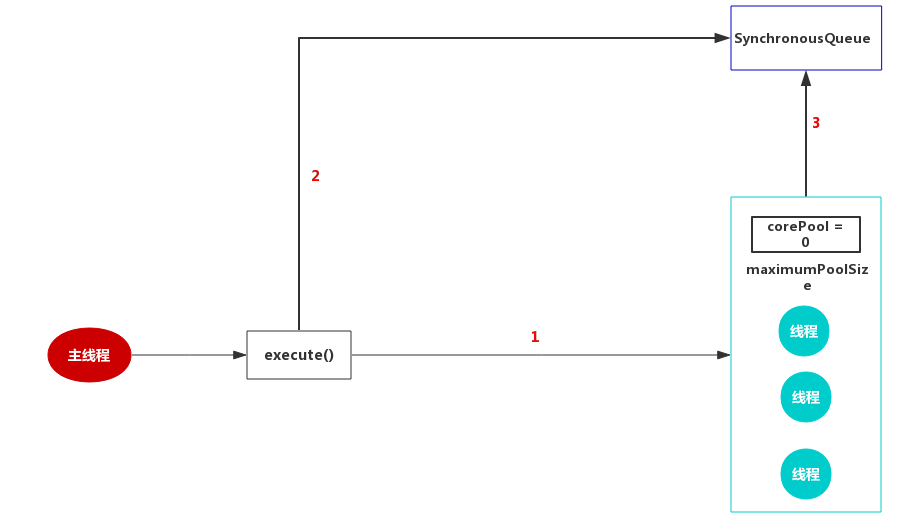四种线程池
1 FixedThreadPool
FixedThreadPool是复用固定数量的线程处理一个共享的无边界队列,其定义如下:
public static ExecutorService newFixedThreadPool(int nThreads) { return new ThreadPoolExecutor(nThreads, nThreads, 0L, TimeUnit.MILLISECONDS, new LinkedBlockingQueue<Runnable>()); }
corePoolSize 和 maximumPoolSize都设置为创建FixedThreadPool时指定的参数nThreads,由于该线程池是固定线程数的线程池,当线程池中的线程数量等于corePoolSize 时,如果继续提交任务,该任务会被添加到阻塞队列workQueue中,而workQueue使用的是LinkedBlockingQueue,但没有设置范围,那么则是最大值(Integer.MAX_VALUE),这基本就相当于一个无界队列了。

案例:
import java.util.concurrent.ExecutorService; import java.util.concurrent.Executors; public class FixedThreadPoolTest { public static void main(String[] args) { ExecutorService service= Executors.newFixedThreadPool(3); for (int i = 0; i < 5; i++) { service.execute(()->{ System.out.println(Thread.currentThread().getName()+"执行"); }); }
exec.shutdown();
} }
2 SingleThreadExecutor
SingleThreadExecutor只会使用单个工作线程来执行一个无边界的队列。
public static ExecutorService newSingleThreadExecutor() { return new FinalizableDelegatedExecutorService (new ThreadPoolExecutor(1, 1, 0L, TimeUnit.MILLISECONDS, new LinkedBlockingQueue<Runnable>())); }
作为单一worker线程的线程池,它把corePool和maximumPoolSize均被设置为1,和FixedThreadPool一样使用的是无界队列LinkedBlockingQueue,所以带来的影响和FixedThreadPool一样。
SingleThreadExecutor只会使用单个工作线程,它可以保证认为是按顺序执行的,任何时候都不会有多于一个的任务处于活动状态。注意,如果单个线程在执行过程中因为某些错误中止,新的线程会替代它执行后续线程。

案例:
public class Demo9SingleThreadPoolCase { static int count = 0; public static void main(String[] args) throws InterruptedException { ExecutorService exec = Executors.newSingleThreadExecutor(); for (int i = 0; i < 10; i++) { exec.execute(new Demo()); Thread.sleep(5); } exec.shutdown(); } static class Demo implements Runnable { @Override public void run() { String name = Thread.currentThread().getName(); for (int i = 0; i < 2; i++) { count++; System.out.println(name + ":" + count); } } } }
3 CachedThreadPool
CachedThreadPool会根据需要,在线程可用时,重用之前构造好的池中线程,否则创建新线程:
public static ExecutorService newCachedThreadPool() { return new ThreadPoolExecutor(0, Integer.MAX_VALUE, 60L, TimeUnit.SECONDS, new SynchronousQueue<Runnable>()); }
它把corePool为0,maximumPoolSize为Integer.MAX_VALUE,这就意味着所有的任务一提交就会加入到阻塞队列中。因为线程池的基本大小设置为0,一般情况下线程池中没有程池,用的时候再创建。
但是keepAliveTime设置60,unit设置为秒,意味着空闲线程等待新任务的最长时间为60秒,空闲线程超过60秒后将会被终止。阻塞队列采用的SynchronousQueue,这是是一个没有元素的阻塞队列。
这个线程池在执行 大量短生命周期的异步任务时,可以显著提高程序性能。调用 execute 时,可以重用之前已构造的可用线程,如果不存在可用线程,那么会重新创建一个新的线程并将其加入到线程池中。如果线程超过 60 秒还未被使用,就会被中止并从缓存中移除。因此,线程池在长时间空闲后不会消耗任何资源。
但是这样就处理线程池会存在一个问题,如果主线程提交任务的速度远远大于CachedThreadPool的处理速度,则CachedThreadPool会不断地创建新线程来执行任务,这样有可能会导致系统耗尽CPU和内存资源,所以在使用该线程池是,一定要注意控制并发的任务数,否则创建大量的线程可能导致严重的性能问题。

案例:
public class Demo9CachedThreadPoolCase { public static void main(String[] args) throws InterruptedException { ExecutorService exec = Executors.newCachedThreadPool(); for (int i = 0; i < 10; i++) { exec.execute(new Demo()); Thread.sleep(1); } exec.shutdown(); } static class Demo implements Runnable { @Override public void run() { String name = Thread.currentThread().getName(); try { //修改睡眠时间,模拟线程执行需要花费的时间 Thread.sleep(1); System.out.println(name + "执行完了"); } catch (InterruptedException e) { e.printStackTrace(); } } } }
4 ScheduledThreadPool
Timer与TimerTask虽然可以实现线程的周期和延迟调度,但是Timer与TimerTask存在一些问题:
- Timer在执行定时任务时只会创建一个线程,所以如果存在多个任务,且任务时间过长,超过了两个任务的间隔时间,会发生一些缺陷。
- 如果TimerTask抛出RuntimeException,Timer会停止所有任务的运行。
- Timer执行周期任务时依赖系统时间,如果当前系统时间发生变化会出现一些执行上的变化
为了解决这些问题,我们一般都是推荐ScheduledThreadPoolExecutor来实现。
ScheduledThreadPoolExecutor,继承ThreadPoolExecutor且实现了ScheduledExecutorService接口,它就相当于提供了“延迟”和“周期执行”功能的ThreadPoolExecutor。
ScheduledThreadPoolExecutor,它可另行安排在给定的延迟后运行命令,或者定期执行命令。需要多个辅助线程时,或者要求 ThreadPoolExecutor 具有额外的灵活性或功能时,此类要优于Timer。
提供了四种构造方法:
public ScheduledThreadPoolExecutor(int corePoolSize) { super(corePoolSize, Integer.MAX_VALUE, 0, NANOSECONDS, new DelayedWorkQueue()); } public ScheduledThreadPoolExecutor(int corePoolSize, ThreadFactory threadFactory) { super(corePoolSize, Integer.MAX_VALUE, 0, NANOSECONDS, new DelayedWorkQueue(), threadFactory); } public ScheduledThreadPoolExecutor(int corePoolSize, RejectedExecutionHandler handler) { super(corePoolSize, Integer.MAX_VALUE, 0, NANOSECONDS, new DelayedWorkQueue(), handler); } public ScheduledThreadPoolExecutor(int corePoolSize, ThreadFactory threadFactory, RejectedExecutionHandler handler) { super(corePoolSize, Integer.MAX_VALUE, 0, NANOSECONDS, new DelayedWorkQueue(), threadFactory, handler); }
在ScheduledThreadPoolExecutor的构造函数中,我们发现它都是利用ThreadLocalExecutor来构造的,唯一变动的地方就在于它所使用的阻塞队列变成了DelayedWorkQueue。
DelayedWorkQueue为ScheduledThreadPoolExecutor中的内部类,类似于延时队列和优先级队列。在执行定时任务的时候,每个任务的执行时间都不同,所以DelayedWorkQueue的工作就是按照执行时间的升序来排列,执行时间距离当前时间越近的任务在队列的前面,这样就可以保证每次出队的任务都是当前队列中执行时间最靠前的。
案例:
import java.util.Date; import java.util.concurrent.Executors; import java.util.concurrent.ScheduledExecutorService; import java.util.concurrent.TimeUnit; public class ScheduledThreadPoolTest { public static void main(String[] args) { ScheduledExecutorService service= Executors.newScheduledThreadPool(2); System.out.println("程序开始时间:"+new Date()); Runnable runnable=()->{ System.out.println(new Date()+Thread.currentThread().getName()); }; service.schedule(runnable, 0, TimeUnit.SECONDS); service.schedule(runnable, 1, TimeUnit.SECONDS); service.schedule(runnable, 5, TimeUnit.SECONDS); service.shutdown(); } }





 浙公网安备 33010602011771号
浙公网安备 33010602011771号